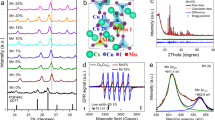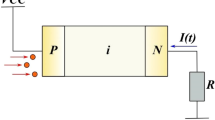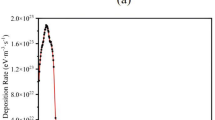Abstract
Micronuclear batteries harness energy from the radioactive decay of radioisotopes to generate electricity on a small scale, typically in the nanowatt or microwatt range1,2. Contrary to chemical batteries, the longevity of a micronuclear battery is tied to the half-life of the used radioisotope, enabling operational lifetimes that can span several decades3. Furthermore, the radioactive decay remains unaffected by environmental factors such as temperature, pressure and magnetic fields, making the micronuclear battery an enduring and reliable power source in scenarios in which conventional batteries prove impractical or challenging to replace4. Common radioisotopes of americium (241Am and 243Am) are α-decay emitters with half-lives longer than hundreds of years. Severe self-adsorption in traditional architectures of micronuclear batteries impedes high-efficiency α-decay energy conversion, making the development of α-radioisotope micronuclear batteries challenging5,6. Here we propose a micronuclear battery architecture that includes a coalescent energy transducer by incorporating 243Am into a luminescent lanthanide coordination polymer. This couples radioisotopes with energy transducers at the molecular level, resulting in an 8,000-fold enhancement in energy conversion efficiency from α decay energy to sustained autoluminescence compared with that of conventional architectures. When implemented in conjunction with a photovoltaic cell that translates autoluminescence into electricity, a new type of radiophotovoltaic micronuclear battery with a total power conversion efficiency of 0.889% and a power per activity of 139 microwatts per curie (μW Ci−1) is obtained.
This is a preview of subscription content, access via your institution
Access options
Access Nature and 54 other Nature Portfolio journals
Get Nature+, our best-value online-access subscription
$32.99 / 30 days
cancel any time
Subscribe to this journal
Receive 51 print issues and online access
$199.00 per year
only $3.90 per issue
Buy this article
- Purchase on SpringerLink
- Instant access to full article PDF
Prices may be subject to local taxes which are calculated during checkout




Similar content being viewed by others
Data availability
All the data presented in this work are fully available from the corresponding authors. Source data for Figs. 2–4 are provided in the Supplementary Source Data. The crystallographic data have been deposited at the Cambridge Crystallographic Data Centre with numbers 2330767, 2330769, 2330771, 2331023, 2331108 and 2331024. These data can be obtained free of charge from the Cambridge Crystallographic Data Centre at http://www.ccdc.cam.ac.uk/data_request/cif. Source data are provided with this paper.
Code availability
Code source data for all simulations in this work are provided as Supplementary Source Code, with all relevant information for reproduction described in the text and supplementary materials.
References
Prelas, M. A. et al. Nuclear Batteries and Radioisotopes (Springer, 2016).
Prelas, M. A. et al. A review of nuclear batteries. Prog. Nucl. Energ. 75, 117–148 (2014).
Olsen, L. C., Cabauy, P. & Elkind, B. J. et al. Betavoltaic power sources. Phys. Today 65, 35–38 (2012).
Spencer, M. G., & Alam, T. High power direct energy conversion by nuclear batteries. Appl. Phys. Rev. 6, 031305 (2019).
Liu, B. J. et al. Alpha-voltaic battery on diamond Schottky barrier diode. Diam. Relat. Mater. 87, 35–42 (2018).
Weaver, C. L. et al. Radiation resistant PIDECα cell using photon intermediate direct energy conversion and a 210Po source. Appl. Radiat. Isotopes. 132, 110–115 (2018).
Nullmeyer, B. R. et al. Self-healing effects in a semi-ordered liquid for stable electronic conversion of high-energy radiation. Sci Rep. 8, 12404 (2018).
Gao, R. et al. Isoelectronic aluminum-doped gallium nitride alpha-voltaic cell with efficiency exceeding 4.5%. Commun Mater. 4, 50 (2023).
Sychov, M. et al. Alpha indirect conversion radioisotope power source. Appl. Radiat. Isotopes 66, 173–177 (2008).
Cress, C. D., Landi, B. J., Raffaelle, R. P. & Wilt, D. M. InGaP alpha voltaic batteries: synthesis, modeling, and radiation tolerance. J. Appl. Phys. 100, 114519 (2006).
Sperling, J. M. et al. Structural and spectroscopic investigation of two plutonium mellitates. Inorg. Chem. 59, 3085–3090 (2020).
Sperling, J. M. et al. Pronounced pressure dependence of electronic transitions for americium compared to isomorphous neodymium and samarium mellitates. Inorg. Chem. 60, 476–483 (2020).
Sperling, J. M. et al. C Synthesis, characterization, and high-pressure studies of a 3D berkelium(III) carboxylate framework material. Chem. Commun. 58, 2200–2203 (2022).
Galley, S. S. et al. Synthesis and characterization of tris-chelate complexes for understanding f-orbital bonding in later actinides. J. Am. Chem. Soc. 141, 2356–2366 (2019).
Marcelo, O. R. et al. Modeling, structural, and spectroscopic studies of lanthanide-organic frameworks. J. Phys. Chem. B 113, 12181–12188 (2009).
Knoll, G. F. Radiation Detection and Measurement (Wiley, 2010).
Tsoulfanidis, N. et al. Measurement and Detection of Radiation (CRC Press, 2021).
Horrocks, D. L. The mechanisms of the liquid scintillation process. Liq. Scintillation 1976, 1–16 (1976).
Gilson, S. E. et al. Unprecedented radiation resistant thorium–binaphthol metal–organic framework. J. Am. Chem. Soc. 142, 13299–13304 (2020).
Zhu, L. et al. Identifying the recognition site for selective trapping of 99TcO4– in a hydrolytically stable and radiation resistant cationic metal–organic framework. J. Am. Chem. Soc. 139, 14873–14876 (2017).
David, P. M. et al. A mixed-cation lead mixed-halide perovskite absorber for tandem solar cells. Science 351, 151–155 (2016).
Yin, J. W. et al. Tuning octahedral tilting by doping to prevent detrimental phase transition and extend carrier lifetime in organometallic perovskites. J. Am. Chem. Soc. 145, 5393–5399 (2023).
Russo, J. et al. A radioluminescent nuclear battery using volumetric configuration: 63Ni solution/ZnS:Cu,Al/InGaP. Appl. Radiat. Isotopes 130, 66–74 (2017).
Jiang, T. et al. In-depth analysis of the internal energy conversion of nuclear batteries and radiation degradation of key materials. Energy Technol. 8, 2000667 (2020).
Xu, Z. et al. Enhanced radioluminescent nuclear battery by optimizing structural design of the phosphor layer. Int. J. Energy Res. 42, 1729–1737 (2018).
Tang, X. et al. Physical parameters of phosphor layers and their effects on the device properties of beta-radioluminescent nuclear batteries. Energy Technol. 3, 1121–1129 (2015).
Tang, X.-B. et al. Temperature effect of a radioluminescent nuclear battery based on 147Pm/ZnS:Cu/GaAs. Appl. Radiat. Isotopes 97, 118–124 (2015).
Xu, Z. et al. Designing performance enhanced nuclear battery based on the Cd-109 radioactive source. Int. J. Energy Res. 44, 508–517 (2020).
Ambadas, B. P. Novel nuclear batteries based on radioluminescence. Energy Technol. 10, 2200285 (2022).
Lei, Y. Demonstration and aging test of a radiation resistant strontium-90 betavoltaic mechanism. Appl. Phys. Lett. 116, 153901 (2020).
Dolomanov, O. V. et al. OLEX2: a complete structure solution, refinement and analysis program. J. Appl. Cryst. 42, 339–341 (2009).
Sheldrick, G. M. SHELXT – integrated space-group and crystal-structure determination. Acta Crystallogr. A 71, 3–8 (2015).
Sheldrick, G. M. Crystal structure refinement with SHELXL. Acta Crystallogr. C 71, 3–8 (2015).
Wrighton, M. S., Ginley, D. S. & Morse, D. L. A technique for the determination of absolute emission quantum yields of powdered samples. J. Phys. Chem. 78, 2229–2232 (1974).
Wang, J.-X. et al. Heavy-atom engineering of thermally activated delayed fluorophores for high-performance X-ray imaging scintillators. Nat. Photon. 16, 869–875 (2022).
Yang, L. et al. Emergence of a lanthanide chalcogenide as an ideal scintillator for a flexible X-ray detector. Angew. Chem. Int. Ed. 62, e202306465 (2023).
Wang, J.-X. et al. Aggregation-induced fluorescence enhancement for efficient X-ray imaging scintillators and high-speed optical wireless communication. ACS Materials Lett. 9, 1668–1675 (2022).
Agostinelli, S. et al. GEANT4—a simulation toolkit. Nucl. Instrum. Methods Phys. Res. A 506, 250–303 (2003).
Allison, J. et al. Recent developments in Geant4. Nucl. Instrum. Methods Phys. Res. A 835, 186–225 (2016).
Acknowledgements
We acknowledge funding support from the National Natural Science Foundation of China (22425061, 22222606, 22206143 and 22227809), the Natural Science Foundation of Jiangsu Province (BK20211546) and the New Cornerstone Science Foundation through the XPLORER PRIZE. We thank R. Wang of Soochow University and Y. Han of the Institute of Nuclear Energy Safety Technology for their advice in improving the paper. We also acknowledge R. Liu, Z. Liu and Y. Wang at Soochow University for their suggestions on photovoltaic cell preparation.
Author information
Authors and Affiliations
Contributions
S.W., Yaxing Wang and X.O. conceived and supervised the project. K.L. designed the experiment and participated in the entire project. J.W., Y.Z., H.Z. and Y.S. performed the crystal growth and structural determination. J.G., G.S., J.Y. and W.M. carried out the photovoltaic cell fabrication experiment. C.Y., K.Z., Y.Y. and L.S. performed the Monte Carlo simulation. L.C. and Yumin Wang performed the autoluminescent property measurements. K.L. and G.J. determined the electrical characteristics of the nuclear battery. Z.C. aided in the discussion. S.W., Yaxing Wang and K.L. prepared the manuscript. All authors discussed the results and commented on the paper.
Corresponding authors
Ethics declarations
Competing interests
S.W., Yaxing Wang, K.L. and Soochow University have filed a patent on the presenting results. The other authors declare no competing interests.
Peer review
Peer review information
Nature thanks Eric Lukosi, Robert Surbella and the other, anonymous, reviewer(s) for their contribution to the peer review of this work. Peer reviewer reports are available.
Additional information
Publisher’s note Springer Nature remains neutral with regard to jurisdictional claims in published maps and institutional affiliations.
Supplementary information
Supplementary Information
This file includes Supplementary Figs. 1–26 and Supplementary Tables 1–8.
Supplementary Source Code
Supplementary crystallographic information files with CCDC deposit numbers 2330767, 2330769, 2330771, 2331023, 2331108 and 2331024.
Rights and permissions
Springer Nature or its licensor (e.g. a society or other partner) holds exclusive rights to this article under a publishing agreement with the author(s) or other rightsholder(s); author self-archiving of the accepted manuscript version of this article is solely governed by the terms of such publishing agreement and applicable law.
About this article
Cite this article
Li, K., Yan, C., Wang, J. et al. Micronuclear battery based on a coalescent energy transducer. Nature 633, 811–815 (2024). https://doi.org/10.1038/s41586-024-07933-9
Received:
Accepted:
Published:
Issue date:
DOI: https://doi.org/10.1038/s41586-024-07933-9
This article is cited by
-
High-efficiency 90Sr radio-photovoltaic cells based on waveguide light concentration structure
Light: Science & Applications (2025)
-
Rational design of a rare N-coordinated thorium organic framework for efficient CO2 capture and catalytic conversion
Science China Chemistry (2025)



